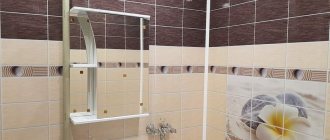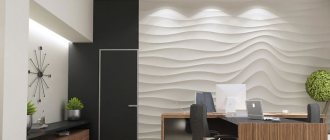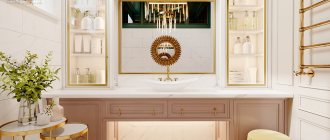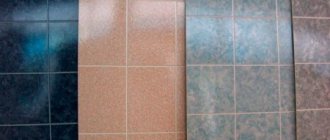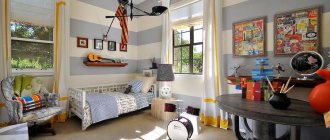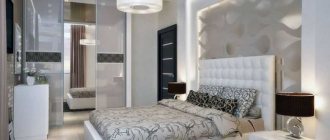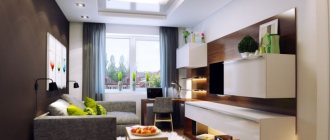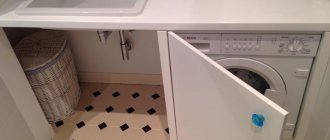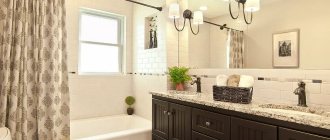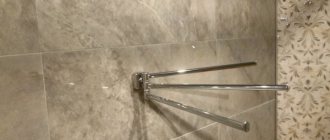Photo: dbsbathrooms.co.uk
Photo: targwall.co.uk
Leafy
This type of panel is the most popular when decorating a bathroom.
Thanks to sheet panels, you can decorate a room in a very short time, and all this is due to their size (they are up to three meters long). Just like tiled ones, they are made with a textured surface, most often stone or wood. Such panels are attached with special glue, and if seams form between them, moldings will be needed.
As a rule, sheet panels are sold with a pattern already applied, so to get a solid picture you just need to fasten them together, like a puzzle.
Photo: solwd.net
Photo: dbsbathrooms.co.uk
Features of using panels in the bathroom
Panels are a finishing material in the form of rectangular, slatted or square sheets that can be used for external decoration of walls, floors and ceilings.
Siding for a bathroom can be made from various materials, but most often various types of plastic, laminate, acrylic and others are used. Various designs can be applied on top of such material - from abstract patterns to photorealistic paintings and imitation ceramic tiles.
Other features:
- The panels vary greatly in size. Their length usually ranges from 1.5 to 5 meters, width - from 12 to 40 centimeters, thickness - 8-12 millimeters.
- The variety of sizes allows you to choose the optimal finishing material. Panel structures can be laid in both horizontal and vertical directions.
Important! If necessary, the panels can be cut to any size to adjust the material to the size of the bathroom.
Pros and cons of paneling
Panels for bathroom design have the following advantages compared to traditional tiles:
- Easy to install . In an apartment, the panels are mounted using self-tapping screws on the sheathing (frame) or directly placed on glue, and a medium-sized bathroom can be finished in a day.
- Low price . The panels are usually made of plastic, which is moderately priced. And you can get such material at almost any hardware store.
- Nice appearance . Panels can have different appearances - from white monochrome to full-fledged patterns. Also, in appearance, they can imitate ceramics, wood, and so on.
However, the panels also have certain disadvantages:
- Poor strength . Plastic panels are quite easily deformed, and in the event of an impact, they leave dents that look bad. Although, if necessary, you can always replace the damaged fragment.
- Mediocre technical properties . Very cheap types of panels have poor water resistance, promote the growth of fungus, and have an unpleasant odor (critical for a child’s room). However, more expensive products do not have these disadvantages.
Disadvantages of finishing a bathroom with plastic:
Even such seemingly ideal panels have their drawbacks. There are few of them compared to the advantages, but we must tell you about them.
Fragility
If during installation you drop something heavy on the panel, it may crack or even break. So we can’t talk about super resistance to shock loads. If you suddenly want to punch a wall or throw something at it, think ten times.
Difficulty in arranging a room
Drilling holes for cabinets and shelves in plastic panels can be difficult, as they can crack and lose their attractive appearance.
Downsizing a room
If the room cannot boast of a large footage, finishing with plastic panels is not the best option. Lathing and cladding take up to five centimeters of usable bathroom space.
Unattractive appearance
This can only happen if poor quality panels are used with an uneven surface, which can cause gaps to form between them. This increases the threat of mold and mildew intrusion.
Calculate the exact cost of repairs using an online calculator
and receive a free detailed estimate for repairs
Calculate
Photo: bathroomcladdingdirect.co.uk
Main types of bathroom panels
There are the following types of wall panels:
- Leafy . They have the appearance of a rectangle, with a length of 2-5 meters and a width of 12-40 centimeters. A universal material for bathrooms of any size.
- Rack and pinion They are made in the form of narrow rectangles (slats), the length of which is within 2-5 meters, and the width is 5-10 centimeters. Used for finishing small rooms, as well as for ceilings.
- Square . They are made in the form of squares, the width of the walls ranges from 20 centimeters to 2 meters. Used for finishing small areas (for example, to create a pattern on one of the walls).
3D panels
This type of finishing is at the peak of popularity today. Volumetric mosaic created from different materials (wood, glass, plaster, plastic) allows you to add sophistication to the room. At the same time, the materials used to make wall panels can be completely natural, they do not cause allergies, are easy to clean and retain their original appearance for a long time.
Your renovation will still look fresh and neat in a few years. They look great in the bedroom and living room and will create a voluminous fairy tale in your child’s room. They do not deform and are not afraid of dampness. Easy to install, you can choose a finish in a suitable price category. They fit perfectly into any room and can be used to create a variety of interior styles.
3D gypsum panels have their own twist Source roomester.ru
Types of panels made of different materials
The panels are made from various materials - PVC, MDF, seamless plastic, acrylic, glass and others. Below the main types of panels will be discussed.
PVC
PVC plastic has good elasticity, does not allow water to pass through and is resistant to slight deformation. It is lightweight and easy to transport and install.
Various designs can be applied to the surface of the material - for example, landscape, flowers, drops, geometric patterns, abstraction, and so on.
Installation diagram of PVC panels
MDF panels
They are made on the basis of pressed wood dust with protective impregnation. The material has excellent strength and environmental friendliness, does not allow water to pass through, and retains heat well.
However, it is heavier and cannot be painted on its surface.
SIP panels
The material consists of two layers of wood, between which there is a heat insulator (expanded polystyrene foam or polyurethane foam).
The material retains heat well, protects against water, and has good strength and reliability. However, SIP boards are expensive and have a large thickness (from 10 millimeters).
Seamless plastic
They are narrow slabs 15-25 centimeters wide, based on PVC, which do not have connecting grooves.
Thanks to this property, you can create a coating that will have no seams, which will allow you to create a beautiful finish (for example, you can make a large drawing in the vision of a stylish plant). However, seamless plastic is more expensive, and it is a little more difficult to install.
Acrylic
In terms of technical and aesthetic properties, acrylic is similar to PVC - it has an interesting, pleasant appearance, it is easy to transport and install, it has good heat and moisture resistance, and so on.
In addition, acrylic has higher strength and is easy to care for. However, acrylic costs several times more than PVC, which makes it less popular.
Tiled
Tile panels are usually made from PVC or acrylic. Their main feature is the presence of a pattern that completely imitates ceramic tiles.
The material is suitable for people who really love ceramics, but they do not have the time, energy or experience to install full-fledged tiles.
Glass
Glass panels have the form of rectangles and squares, under which you can make a lining to create a pattern (for example, a flower). Photo design using glass is highly hygienic, and if necessary, it can be quickly washed.
But cladding with glass also has disadvantages - the material is expensive, highly fragile, more difficult to install, and in the case of a large bathroom area, repairs will cost a pretty penny.
Laminate
Laminated boards are made from fiberboard, which is additionally coated with a waterproof coating, which makes it possible to use it in bathrooms.
Laminate is characterized by good strength, low weight, and various designs (for example, flowers) can be applied to its surface. However, it is more demanding in terms of installation, so it is more difficult to install.
Aquapanels
Aquapanel is a fashionable fiberglass mesh filled with expanded clay. The material perfectly withstands exposure to high and low temperatures, does not crack over time, and withstands water and mechanical shocks well.
However, the aquapanel can only be attached to a special coating based on a metal facade (lathing).
Mosaic
The mosaic panel is made from plastic or acrylic with the appropriate technical characteristics. The main feature is the presence of a mosaic pattern, which can have different colors.
There are several hundred design options on sale, so a person can easily choose the best option for himself.
Decorative panels
Decorative panels are also made on the basis of acrylic or PVC. Various unique designs are applied to their surface - flowers, landscapes, various objects, abstract patterns, and so on.
The panel can be installed either on the entire wall or on a separate fragment of it (for example, to decorate the space around a mirror).
What tools will you need?
It is worth preparing to work with PVC panels. First of all, you will need to find a special tool:
- Circular Saw. If you can’t find it, you can use a jigsaw. The file or disk must have fine teeth (“clean cut”). It is preferable to use a saw. The jigsaw file is highly flexible, so the cut can turn out wavy.
- Jigsaw cutter with angles of 45 and 90 degrees.
- Construction stapler for cladding on wooden sheathing.
- Rubber mallet with a hook rule. The same tool is used for installing laminate flooring. Needed to “rip out” jammed panels. Doing this with your hands can easily damage the panel or sheathing.
- A plaster spatula used to bend the finishing profile when installing the last plank. Spatula length 80-120 cm.
Also when performing work you will need:
- pencil and tape measure;
- building level;
- square;
- fastening elements (self-tapping screws, dowel-nails, clamps);
- screwdriver;
- perforator;
- sealant;
- antiseptic.
Wall decoration with PVC panels
PVC panels are easy to install on the wall, and their use allows you to create a good quality coating. Plastic blocks will not accumulate water or deform under the influence of temperature changes.
It is recommended to make small blocks in the walls below where you can hide water pipes, a bathroom and electrical wiring.
To remove external structures (for example, hooks for a mirror), it is necessary to provide small holes in the PVC. The joints between the coating and the PVC wall should be sealed with sealant.
Properties and characteristics
PVC panels contain polyvinyl chloride, which is a lightweight and high-quality material. Due to this, the ceilings in rooms, offices and supermarkets are often covered with these panels. Also, interesting patterns are depicted on PVC panels using lamination, thermal printing and other modern technologies. After this, a matte or glossy varnish is applied to this material, which protects the material.
Thanks to this treatment, the panel does not wear out quickly and is very resistant to ultraviolet rays, as well as to any damage, for example, it is protected from scratches. For the safety of human health and his family, no harmful chemical components are used in the production of such polyvinyl chloride panels. Also, when painting surfaces, only water-based paints are used, which is also absolutely safe.
There is a difference between the plastic panels used on walls and ceilings. It lies in the fact that wall-mounted options are a little stronger, and they are also not flexible, so such panels can withstand heavy mechanical loads. Also, the options for walls are thicker than for ceilings. The more polyvinyl chloride, the thicker the panel. The stiffening ribs located inside the PVC wall panels are 1 mm thick, so cutting them with a knife will not be so easy.
The length of this material is 3 meters, the width is only 10 cm, and sometimes it can reach up to 12.5 cm. Plastic lining can be used for both external and internal treatment of premises. In total, two types of this material have become popular on the market. These are “Polka” and “European”. The “polka” has a small locking connection, while the “European” has a much wider one.
External PVC panels have a seam. This is due to the fact that the material has a high coefficient of linear expansion. Therefore, the lining, which was not installed indoors, must change due to changes in temperature conditions. There is also another feature of façade lining. It lies in the fact that the coloring of raw materials in various colors occurs during production, and is not applied on top as in other types. Because of this, the lining retains its original color longer.
Sheet panels consisting of plastic are wider than those of plastic lining. Their length ranges from 105 to 405 cm. These panels are the most famous and consumed. Sometimes the surface of the sheets is sent for special treatment, but not everyone does this, but only some good manufacturers. Thanks to this operation, the panels become stronger and more stable.
Sheet panels can be mounted using glue and nails. The cracks can be sealed with a sealant of the appropriate color or with a narrow lath. Conventional panels have a length of 260 and 270 cm, sometimes even 300 cm, and a width of about 25 cm. But you can also use panels with a width of 50 cm for finishing rooms. The varnished and painted side of the outer surface also forms a seam, which is not very noticeable when it takes on a assembled appearance.
There are also GOST sandwich PVC panels, which are modern and have high performance. The peculiarity of these panels is the presence of two sheets of plastic. Polyurethane foam or expanded polystyrene foam are used as various added substances; they give the material thermal insulation properties. The degree of flammability of products is indicated on the packaging. Plastic lining has the highest coefficient.
How to choose the right panels for the bathroom
When choosing panels, remember the following important points:
- Pay attention to the number of stiffening ribs on the panels. The more ribs there are, the stronger the material will be, which can affect the shelf life of the structure. The profile stiffeners must be even and smooth. If there are signs of deformation, it is recommended to refuse to purchase the material.
- Before purchasing, be sure to pay attention to the strength, resistance to water and temperature changes. Also pay attention to the color and make sure that the color scheme of the material will match the baseboard, toilet, bathtub, and also match the overall style and mood of the house.
Note! It is not recommended to buy black panels - there will often be stains and stains on them.
Preparatory stage
Cladding with PVC panels
Preliminary calculations
You need to start by calculating the amount of finishing material so that you don’t have to overpay or go to the store for an additional batch. The panels can be mounted both vertically and horizontally, depending on the wishes of the apartment owners. When mounting vertically, the number of panels is calculated as follows: measure the length of the perimeter of the room, subtract the width of the openings and divide by the width of one panel. To the resulting number add 2-3 lamellas in reserve.
For horizontal installation, measure the area of the room minus door and window openings and divide by the area of one panel. Here the margin should be at least 10%, since the consumption of material for trimming increases. Additionally, you need to calculate the number of slats for the sheathing and fasteners. First, the height of the walls is divided by the sheathing pitch, which is usually 0.5 m, and multiplied by the perimeter of the room. The resulting number indicates the length of the slats in linear meters. By measuring the height of the corners and multiplying it by their number, we obtain the total footage of the corner profiles; to this number you need to add the perimeter of window and door openings.
Methods for attaching lamellas
How to attach PVC lining to walls
There are three ways to attach panels to the wall - using glue, self-tapping screws and clamps. The first method is suitable for very even and smooth walls; glue is used special for PVC, universal “Moment-installation” or “liquid nails”.
Installation of panels with glue
The use of this method simplifies and reduces the cost of the installation process, since there is no need to attach the sheathing. Disadvantages: it is impossible to replace a damaged panel; during subsequent repairs it is difficult to remove the covering from the wall.
Methods for installing PVC panels on walls
Do-it-yourself installation of PVC panels
Fastening with self-tapping screws is a reliable and convenient option that does not require a perfectly flat surface. To screw in the screws, you definitely need a screwdriver, otherwise the installation process will take a long time. Disadvantages of this method: a wooden frame is better suited for self-tapping screws, so additional time is spent cutting the timber and treating it with an antiseptic.
How to attach plastic panels
The third option is the most optimal. The clamps are conveniently and quickly attached to the sheathing and securely fix the panels to the wall. The lathing is mounted from a metal profile, assembly of the covering is carried out effortlessly. A damaged lamella can be easily replaced with a new one; dismantling the finish also does not take much time.
Installation of PVC panels
Tools and necessary materials
During the work, everything should be at hand, so materials and tools for installation are prepared in advance. You will need:
- fine-toothed hacksaw;
- pencil and tape measure;
- level;
- square;
- plastic panels;
- slats or plastic profile;
- dowel-nails, screws or clamps;
- screwdriver;
- perforator;
- antiseptic composition;
- sealant;
- ceiling plinth.
Preparing the walls
Before covering the walls with panels, you need to clear the old coating, seal every single crack, smooth out noticeable defects and treat the surface with an antifungal agent. Thanks to this, dust will not accumulate under the plastic and mold will not develop, which negatively affects the microclimate in the room. If the installation will be carried out on a frame, it is not necessary to additionally level the surface.
Prices for mixtures for leveling walls and ceilings
Mixtures for leveling walls and ceilings
Calculation of configuration and number of panels
To draw up the project design and calculate the configuration, you need to measure the total width of all the walls in the bathroom, subtract the width of the door, and then divide the final figure by the width of the panel structure.
You need to add about 10-15% to the resulting figure just in case (for example, a calculation error or damage to the unit during transportation). In addition to the base material, you should purchase connecting blocks and corners, fittings, and mounting adhesive.
Advantages of the material
Plastic panels are in no way inferior to tiles. The indisputable advantages of the material are price and excellent sound insulation.
Stylish interior of a hygiene room in dark colors
The range allows you to realize your decor idea using:
- decorative design;
- imitation marble, wood;
- fashionable 3D images;
- photo printing;
- colored background of any shade.
Plastic in a classic bathroom
The palette of PVC panels is varied - from pastel to bright shades, and even deep black with a glossy and matte surface.
Color palette of plastic panels
Which is better - panels or tiles
The answer to this question will depend on your desires and needs:
- Tiles (tiles) are a more difficult material to install, so it is recommended to buy it for people with experience in laying tile blocks. In addition, tiles are a fairly expensive material, so you will have to save up money to purchase them. Tile makes it more difficult to decorate a wall and create a full-fledged design (for example, flowers), although some people like an abstract tile pattern.
- Panels are a more versatile and simple material. Installing panel cladding does not require precise alignment of the walls, and plastic or acrylic panels are cheaper than tiles. It is easier to match the panels to the color of the toilet and bathroom. In addition, it will be much easier to install the material, so even a person without much experience in finishing work can cope with this task.
Advantages and disadvantages
This material has become so popular due to its many advantages.
- Versatility. Typically, PVC panels are used as finishing for walls and ceilings. This material can be used to trim the edges of doors and windows, used in showers and bathtubs, and also under steps to create interesting shapes. Summer residents use this building material to form garden beds.
- Installation is quick and easy. Ordinary homeowners can now decorate a wall or any other surface. The work is done quickly and easily with smooth walls or ceilings. In such situations, they are secured with “liquid nails.” To make curved surfaces smoother, you should use a metal or wooden frame.
- Easy to care for. PVC panels can be wiped with a regular soapy rag, but you should be careful at the joints of the panels, because these areas are weak.
- Such panels are absolutely environmentally friendly. This material is non-toxic and does not release harmful substances into the environment.
- Strength. This indicator depends on the right choice. For ceilings, this material is a little lighter.
- There is sound and heat insulation. These panels create good sound insulation and do not let cold into the room.
- A large number of colors and shades. The standard color of PVC is white, but manufacturers have created a huge number of colors to suit every consumer’s taste. At the moment, panels with patterns or imitation of the texture of stone or wood are popular.
- Moisture resistance. Thanks to their smooth surface, they do not retain moisture. Since the material has no pores, dirt, mold and other harmful microorganisms do not linger on its surface. Therefore, they are often used in rooms where there is high humidity.
- Resistant to sudden temperature changes. Plastic panels can withstand temperatures from -50 to +50 degrees Celsius.
Just like other building materials, PVC panels also have disadvantages.
- Instability to ultraviolet rays. After a certain period of time, white plastic panels may turn yellow and lose their original appearance.
- Instability to impacts. Such panels can withstand some loads, but they are not protected from dents or scratches on the surface of the material.
- The material contains chalk, which is a determining component of the strength of the product. The amount of chalk in the panels is determined solely by the manufacturer.
- Characteristic smell. When purchasing and using the panels, a specific smell is present for several days, but then it completely disappears.
- This plastic cannot be called absolutely safe, as many manufacturers claim. It should not be used to decorate children's rooms.
Methods for installing PVC panels in the bathroom
There are two main methods for installing plastic panels in a bathroom with your own hands:
- Direct wall mounting . The back wall of the panel is coated with glue, and then the material is immediately leaned against the wall. This installation method is very simple. However, direct wall fastening is only suitable for perfectly flat walls, since otherwise the fastening will be unreliable and unsightly.
- Installation on the lathing . A metal or wooden sheathing is attached to the wall, to which the panel is then screwed using self-tapping screws or clamps. This method is more durable and reliable, but it is more labor-intensive and time-consuming.
Note! When mounted with glue, PVC panels can be additionally screwed to the wall using self-tapping screws to increase the strength of the structure.
Video tutorials on finishing bathroom panels
You can find out more information about bathroom finishing using these videos where real people perform bathroom renovations:
A variety of decorative wall panels with photos
The panels vary in shape, have characteristic properties, are used in a particular room, and perform certain functions. The forms are divided into three groups.
- Slatted panels are long planks, for the production of which PVC, fiberboard, chipboard, and MDF are used. They are often mounted in rooms with many corners, in small rooms. Light panels can visually adjust the space of a small room. The horizontal arrangement of the planks will elongate the walls, and the vertical arrangement will visually raise the ceiling of the room. Wall panels of this shape are easy to install; they are attached with staples or screws to aluminum or wooden sheathing.
- Tile panels are square in shape from 30 cm to 1 m. They are fastened with steel plates or glue. If you arrange wall panels on a plane in different ways, you will get interesting options for wall decoration. An impressive touch will be the lighting built between the panels.
- Sheet wall panels are the largest in size (1.22 by 2.44 m, thickness - 3 cm), most often made of PVC and fiberboard. They form a multi-level structure with an applied pattern, texture that imitates other finishing materials (wood, stone, brick) or a combination thereof. The panels are attached with glue, and the seams formed between them are filled with moldings.
Room design with wall panelWall panels in the interior
| Kinds | Material | Advantages | Flaws |
| Wooden panels | Oak, cedar, maple, alder, walnut, pine | Eco-friendly material; Improves the interior; Combines with other facing materials | They do not tolerate moisture; High price |
| MDF - panels | Wood waste compressed under high temperature | They have sound and heat insulating properties; Can be made moisture-resistant, fire-resistant; Easy to care for | Not recommended for use in the kitchen or bathroom |
| Fiberboard - panels | Wood fibers compressed at a temperature of 180-200 C | Wide range of colors and textures | Low moisture resistance |
| Chipboard - panels | Sawdust and shavings impregnated with formaldehyde resins | Big choice panels covered with veneer, plastic | Harmful to humans and the environment; Cannot tolerate high humidity; Difficulties during installation |
| Bamboo panels | Bamboo tess | Easy to install; Withstands changes in humidity; Vapor permeable; Universal; Acceptable price | Cannot withstand severe mechanical damage |
| Gypsum vinyl panels | Vinyl coated drywall | Strong, durable; Combines with other finishing materials | Insufficiently moisture resistant; Not all products are suitable for cleaning |
| Glass panels | Strained glass | Resistant to external natural influences and moisture; Serve as a solid basis for creating drawings | Do not clean with products containing abrasives; Difficulty in cleaning the surface in the form of streaks and stains; Exposure to direct sunlight will damage the pattern on the panels over time |
| Stone veneer | cut stone | Environmentally friendly and safe material; Durable and reliable; Adapts to any surface shape | High price |
| Soft panels | Leather, textiles | Easy to care for; Resistance to moisture, sunlight and temperature changes; Soundproofing | Frequent cleaning required; For any damage, the entire panel is replaced |
The following types of panels deserve special attention. Some of them appeared relatively recently and differ from previous ones in their originality and creativity.
Modern room design with wall panel
Apartment interior with wall panel
Self-adhesive
Self-adhesive wall panels are popular due to their versatility and positive characteristics. In addition to the advantages described above, this type of product is not susceptible to mold or rotting. It comfortably tolerates temperature changes, which allows the panels to be used in the bathroom.
A distinctive feature is simple installation. No special tools or knowledge required. It is enough to remove the protective film and apply the panel with the desired side to the surface, give it time to stick. Therefore, cladding is quick and easy. Self-adhesive elements can be of different shapes, including rectangular and square.
A distinctive feature is simple installation.
Heat-resistant (fireproof)
An excellent solution for the area next to the stove. The fire-resistant type is divided into several types. The difference between them lies in the reaction to the flame, the increase in temperature indicators, the composition and processing of the material. The ease of combustion and the toxicity of substances released during combustion depend on this.
The best are panels made of completely non-flammable materials that will not catch fire from a spark or a full-fledged flame.
There are products that are difficult to burn. The peculiarity is that they themselves do not ignite, but when exposed to fire, a fire will start. Products of medium thickness are suitable for walls.
The best are panels made of completely non-flammable materials that will not catch fire from a spark or a full-fledged flame.
Colored
They are PVC plates that are made using colored material. Painting occurs with special dyes that penetrate completely into the depth of the product. Color options expand the possibilities of using the panels.
Color options expand the possibilities of using the panels.
Other possible options
There are options using office printing and flexography. Special machines are used that take part in the decoration of wall panels. The machine rolls over the surface, leaving a pattern. There is also a type of products with thermal printing. The decor is applied using high temperatures and special paint. These methods make it possible to obtain original products, perhaps even with an individual design.
The decor is applied using high temperatures and special paint.
How much to buy
Accuracy of calculation is the key to budget savings. Calculating surface area is not enough, because corners and transitions will not allow for waste.
Their volume increases when choosing lamellas with asymmetrical patterns. It is not possible to use pieces with this decor in other places in the bathroom.
Variety with narrow stripes
Therefore, for standard slabs you should buy 10-15% more of the surface area to be finished. For complex designs, it is better to calculate the number of panels individually.
It is better to buy screws, self-tapping screws, and clamps in packs, because it is impossible to count their exact number. It is easier with slats and profiles, because they divide the surface into squares, but it is preferable to purchase with a reserve.
This material currently has great potential
Advice When preparing for installation, it is better to first assemble the drawing and attach it to the wall using tape. This will help avoid errors in calculations.
TOP 8 undeniable advantages of plastic panels
1Rich assortment.
2Moisture resistance.
3Quick installation.
4Communications are hidden under the panels.
5If necessary, additional insulation and sound insulation can be done.
6The panels are easy to care for.
7Low cost of the product.
8A damaged panel can be easily replaced.
VIDEO: Small bath
Small bath
All the secrets of a small space
Installation can be done by anyone
Plastic sheathing is done with your own hands, even without special skills. This is a way to quickly and profitably decorate a room without outside help.
Installation does not require leveling the surfaces with plaster. Frame and adhesive cladding methods are used.
Beautiful plastic lining in the bathroom
For the frame method you need to stock up on:
- drill;
- screwdriver;
- screws and dowels;
- hacksaw;
- pencil;
- triangle;
- tape measure;
- bath baseboard;
- plastic moldings;
- sealant.
Easy to install yourself without seeking help from specialists
Before installation, an antiseptic primer is sprayed onto the surface of the walls to 100% prevent the formation of mold.
How to choose a pattern and color?
The choice of colors, textures and types of prints on the panels is comparable only to wallpaper - there are options on the market for every taste! Thanks to this, you can realize any interesting ideas.
- Plain. Look like painted walls, practical and stylish.
- With imitation material. The higher quality the print, the more natural the result will look. There are stone, wood and metal designs.
- With a repeating pattern. The same image on all planks, which, when assembled, imitates tiles or other finishes.
- With composition. Several elements represent a single picture - a landscape, a still life, an artistic canvas.
The photo shows an apron made of plastic with imitation wood
The choice of plastic panels for the kitchen depends on the size of the room. Small designs, light colors for small kitchens, large prints and dark colors for spacious ones. Materials with a glossy sheen make the room appear larger, while matte materials do not affect the visual size.
They also start from the style: imitation metal will fit into minimalism and high-tech, brickwork into loft and scandi, natural wood into classics.
The photo shows PVC sheets with a brick pattern
